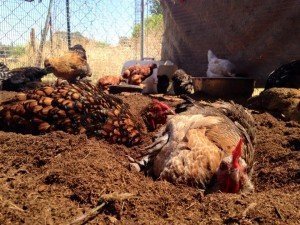Maureen Gruner – Getting to Know You (What the Cluck?)
Hello everyone!
I am Maureen Gruner, an art, game, and animal enthusiast. Of course I love to read too, though I feel that it becomes more of a necessity to life than mere entertainment or a hobby. Language frames our lives quite literally – concepts appear and disappear across the spectrum of language, and so, our writing reflects those ideas found within language and culture. This makes reading an essential part of life and learning. It has become a beloved and integral part of my life and because of this I have decided to major in English education.
I’ve also dedicated myself to chickens. Chickens? Cluck, yeah! Chickens! Back where I live, on a modest and rather green parcel of land stomped into a crevice between the foothills of Browns Valley, I have many chickens. I also have geese, ducks, turkeys, and a single peachick. On the days I don’t have to drive and hour and a half to Chico state, I spend hours out with them. They scratch and peck, crow and strut all over my heart. They’re amazing. All of them have names, and some of them – like most cat owners would empathize with – occasionally grace me with their presence on my lap. Having chickens, I have learned many things about their culture, and yes, they certainly do have cultures. Different flocks actually learn different sounds that directly translate to a concrete meaning.
A high pitched screech issued from a rooster seizes the attention of everyone, and to the sky they look. A turkey vulture sweeps across the open blue and the chickens rush to hide under nearby protection. A hen will “tidbit” to a her kids, signaling she has found a tasty treat, and a rooster who has also learned this technique tidbits to the nearby hens. Only the younger hens fall for it because by now, most of the older ladies have caught onto his ruse – they know a mating trap when they see it.
When chicks hatch, they do not know all of these commands. Chickens from some flocks have more complicated sounds than others because they have taught each other the meanings to these sounds for generations. They learn best in a social setting, because while those sounds and ideas may have a purpose, without context a chick would not know how to use the information. Yes, chickens correlate quite easily to our reading, and I would have to agree with the author that learning is not discrete from our social environment.
“So, what if we adopted a different perspective, one that placed learning in the context of our lived experience of participation in the world? What if we assumed that learning is as much a part of our human nature as eating or sleeping, that it is both life-sustaining and inevitable, and that – given a chance – we are quite good at it? And what it; in addition, we assumed that learning is, in its essence, a fundamentally social phenomenon, reflecting our own deeply social nature as human beings capable of knowing?” (3 Wenger).
Species that live in communal groups rely on other members of their community to teach them about survival. Much as a hen shows her chicks which food is good and which is not by example, we learn from others by how they express and use the knowledge they have obtained. Even our most basic tool to transfer knowledge – language itself – is literally based on social interaction. For what purpose would language serve if it were not used to express ideas to anyone but ourselves? Not being able to share ideas and express intent in a community and having to learn by oneself seems to be quite backward to me. I feel that all it takes is a few minutes with any group of social animals to understand that learning is a community effort, and I like where this book is going.
